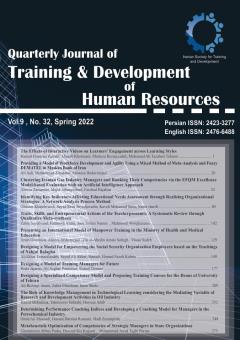Designing a model for human resource empowerment in the National Standard Organization of Iran
Subject Areas :
1 - Justice-oriented university
Keywords: Human resource management, human resource empowerment, National Standard Organization of Iran, productivity,
Abstract :
Today, human resources empowerment is considered as an essential and important process in leading organizations. One of the basic needs of the third millennium organizations, considering the difference and variety of definitions and interpretations in the field of human resources empowerment, is developing a valid and executable model. Therefore, the present study aimed to design a human resource empowerment model in the National Iranian Standards Organization. For this purpose, a qualitative and quantitative mixed approach has been used to design and develop a comprehensive model. Also, the present study is an exploratory, survey, causal, applied and fundamental research in terms of the purpose and method. The research statistical population consists of the staff of the Iranian National Standards Organization (400 persons) as well as experts and academics in the field of human resources empowerment and human resources managers of the Iranian National Standards Organization. In the first step, the categories were extracted by interviewing human resources and human resources empowerment Managers of the Iranian National Standards Organization to design the model; then, the research questionnaire was distributed among the staff of the organization that 302 questionnaires (75.5% rate of return) were returned and analyzed. The results, obtained from the analysis, showed the importance of relationships and components of the proposed model.
[1] A.K. Mishra, Organizational responses to crisis: The role of mutual trust and top management teams, (1992).
[2] Esfandiari, Mohammad Javad, Adabi, Hamidreza. Investigating the relationship between knowledge management and psychological empowerment of human resources in Tehran Municipality. Urban Management Studies, 2016; 8 (25): 12-24.
[3]Abdulli, Abdul Rahim, grandson of Ibrahim, Bijan. Employee Empowerment: The Golden Key to Human Resource Management. Publication of editing.
[4] S. Menon, Employee empowerment: An integrative psychological approach, Appl. Psychol. 50 (2001) 153–180.
[5] L.R. Men, How employee empowerment influences organization–employee relationship in China, Public Relat. Rev. 37 (2011) 435–437.
[6] K. Armitage, Empowering People at Work, Manager. (1998) 28.
[7] Nasrabadi, Mohsen Niazi, Mohammad Karkanan. 1388. "Empowerment based on social capital strategy." Tadbir (1388) 21–26.
[8] K. Grove, J. Pugh, Assemblage thinking and participatory development: Potentiality, ethics, biopolitics, Geogr. Compass. 9 (2015) 1–13.
[9] S.L. Bodner, Dimensional assessment of empowerment in organizations, University of North Texas, 2003.
[10] Moghaddam, Bakhtiari Hassan, Ismail Ahmadi. 2010. "The role of management strategies in empowering managers." Disciplinary Management Studies.
[11] D.M. Chavis, A. Wandersman, Sense of community in the urban environment: A catalyst for participation and community development, in: A Quart. Century Community Psychol., Springer, 2002: pp. 265–292.
[12] A. Wandersman, P. Imm, M. Chinman, S. Kaftarian, Getting to outcomes: A results-based approach to accountability, Eval. Program Plann. 23 (2000) 389–395.
[13] Z. Che, H.S. Wang, C.-L. Chuang, A fuzzy AHP and DEA approach for making bank loan decisions for small and medium enterprises in Taiwan, Expert Syst. Appl. 37 (2010) 7189–7199.
[14] H.K. Spence Laschinger, J. Anne Sabiston, L. Kutszcher, Empowerment and staff nurse decision involvement in nursing work environments: testing Kanter’s theory of structural power in organizations, Res. Nurs. Health. 20 (1997) 341–352.
[15] D. Moura, A. Orgambídez-Ramos, S.N. de Jesus, Psychological empowerment and work engagement as predictors of work satisfaction: A sample of hotel employees, J. Spat. Organ. Dyn. 3 (2015) 125–134.
[16] G.M. Spreitzer, An empirical test of a comprehensive model of intrapersonal empowerment in the workplace, Am. J. Community Psychol. 23 (1995) 601–629.
[17] K.W. Thomas, B.A. Velthouse, Cognitive elements of empowerment: An “interpretive” model of intrinsic task motivation, Acad. Manag. Rev. 15 (1990) 666–681.
[18] A. OrgambÃdez-Ramos, G. Gonçalves, J. Santos, Y. Borrego-Alés, M.I. Mendoza-Sierra, Empowering Employees: A Portuguese Adaptation of the Conditions of Work Effectiveness (CWEQ-II), Psicologia. 29 (2015) 1–10.
[19] M. Lautizi, H.K.S. Laschinger, S. Ravazzolo, Workplace empowerment, job satisfaction and job stress among Italian mental health nurses: an exploratory study, J. Nurs. Manag. 17 (2009) 446–452.
[20] Abbas Saleh Ardestani, Mohammad Hassan Azma ,. (1394). Designing a model of psychological empowerment using the structural equation model in the headquarters of the Martyr and Veterans Affairs Foundation. The first international conference on industrial engineering, management and accounting, electronically, Alborz Research Institute.
[21] Farhad, Abbas Karkaabadi, Alireza Amirkabiri, Lashgar Ara ,. 2011. "Designing a model for human resource empowerment in the Ministry of Interior." Islamic Azad University, Islamic Azad University, Central Tehran Branch, Faculty of Management.
[22] Kurdish, Saeed Abbasi, Baqir. 1388. "Identifying and explaining the model of employee empowerment in Iranian government organizations (Case study of Yazd province)." Management Research 2 (3): 75–94.
[23] L.-C. Wu, C.-S. Ong, Y.-W. Hsu, Knowledge-based organization evaluation, Decis. Support Syst. 45 (2008) 541–549.
[24] D.H. Kim, A framework and methodology for linking individual and organizational learning: Applications in TQM and product development, (1993).
[25] S.E. Seibert, G. Wang, S.H. Courtright, Antecedents and consequences of psychological and team empowerment in organizations: a meta-analytic review., J. Appl. Psychol. 96 (2011) 981.
[26] M. Pigeon, F. Montani, J.-S. Boudrias, How do empowering conditions lead to empowered behaviours? Test of a mediation model, J. Manag. Psychol. (2017).
[27] M. Khaled, M. Ramadan, H. El-Hage, A. Elmarakbi, F. Harambat, H. Peerhossaini, Review of underhood aerothermal management: Towards vehicle simplified models, Appl. Therm. Eng. 73 (2014) 842–858.
[28] T.L. Robbins, M.D. Crino, L.D. Fredendall, An integrative model of the empowerment process, Hum. Resour. Manag. Rev. 12 (2002) 419–443.
[29] A. Newman, C. Dennis, L.-T. Wright, T. King, Shoppers’ experiences of digital signage-a cross-national qualitative study, Int. J. Digit. Content Technol. Its Appl. 4 (2010) 50–57.
[30] L.-Y. Sun, Z. Zhang, J. Qi, Z.X. Chen, Empowerment and creativity: A cross-level investigation, Leadersh. Q. 23 (2012) 55–65.
[31] L. Song, H. Chen, H. Gu, H. Huang, H. Du, Set covering in fuel-considered vehicle routing problems, Theor. Comput. Sci. 607 (2015) 471–479.


